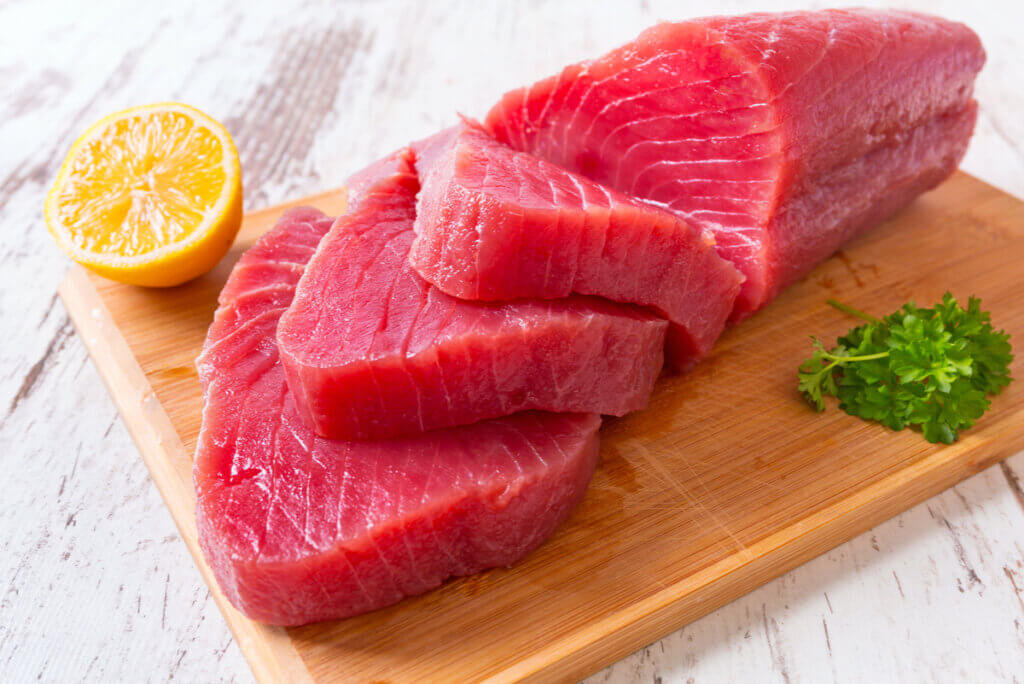3 Types of Fish You Should Avoid


Escrito y verificado por el nutricionista Saúl Sánchez
No one doubts that fish is a healthy food that should appear in any diet. However, there are certain types of fish you should avoid due to the presence of toxins in them that can put your health at risk. We’re going to tell you what they are and the implications of their regular consumption.
It’s advisable to include products from all groups to ensure a complete supply of nutrients in a varied diet. It’s good to prioritize the consumption of fish over red meat due to its content of unsaturated fatty acids and its lower caloric value.
The benefits of eating fish
Among the main benefits of fish consumption, we must highlight that it offers proteins of high biological value. These nutrients contain all the essential amino acids and good digestibility values, which guarantees proper metabolism.
It’s a much more valuable protein than that which comes from foods of vegetable origin. Its regular consumption is associated, for example, with a lower risk of developing diseases that affect lean tissue, according to a study published in the journal Biomed Research International.
On the other hand, it should be noted that fish contains unsaturated fatty acids. Among them, those of the omega 3 series stand out and are capable of modulating inflammation. These lipids have also been shown to help reduce the incidence of cardiovascular-type diseases due to a decrease in the accumulation of triglycerides in the blood.
Fish have a significant amount of micronutrients. Among them is iodine, which is an important mineral when it comes to preventing thyroid-related problems.
There are also varieties of fish with a high calcium content, such as sardines. There’s evidence that adequate consumption of this nutrient reduces the risk of bone fractures in adulthood, a situation capable of conditioning the style and quality of life.

Types of fish
Before discussing in depth which types of fish you should avoid, it should be noted that there are two types of fish, depending on their lipid content. On the one hand, we have oily fish, which are known for containing a significant number of fatty acids in their composition. On the other hand, there are white fish, which have a higher percentage of water and are leaner, as well as less caloric.
Within the context of a varied diet, it’s best to alternate the consumption between both types of food, as each of them provides a certain type of nutrient. At the same time, it’s best to consume products from the sea at least 3 or 4 times a week. This habit is related to a lower risk of being overweight.
3 types of fish you should avoid
We’re going to tell you about the 3 fish that you should avoid. If you do consume them, it must only be occasionally.
1. Panga
This fish has a high content of toxins in its composition, due to the fact that it’s raised in unhygienic conditions. Its meat isn’t highly appreciated and it’s a cheap food that was used in low-quality catering. It’s no longer available in many supermarkets, although it’s still possible to find it in its frozen version.
It’s a food that provides quality protein but a poor lipid profile. At the same time, the diet this fish consumes makes it susceptible to containing waste products in its composition.
It’s a low-cost and disreputable fish. It’s best not to include it in your dietary regimen, as there are other much healthier economic options.
2. Bluefin tuna
Tuna has proteins of high biological value, with high nutritional density and an enviable lipid profile. However, it’s a very large fish that can accumulate significant amounts of heavy metals inside.
These elements are liposoluble in nature and settle in fatty tissue, so, over time, they can pose a health problem. In fact, there’s some evidence that links the intake of these metals with an increased risk of developing diseases.
This class of substances is dangerous for pregnant women, as they can pass to the fetus through the placenta, causing damage during its development. For this reason, during pregnancy, the consumption of large fish should be avoided, as they’re more susceptible to containing heavy metals in their composition.
We shouldn’t eat this type of fish more than once a week, in order to take advantage of its benefits without the risk that a high mercury intake poses to health. It’s possible to find other small oily fish with high nutritional value, as is the case with sardines, for example.
3. Swordfish
The same thing happens here as in the previous case. Swordfish stands out for containing brown meat and a high protein content. Consumed in moderation, it can be a recommended food, as it provides quality nutrients.
However, the fact that it may contain heavy metals in its composition makes it dangerous if ingested regularly, especially for the most sensitive population groups.
Ways of preparing fish
When cooking fish, it’s crucial to take into account some considerations so as not to spoil its nutritional value and get the most out of it. The best options are to resort to grilling or baking, as these are cooking methods that don’t alter the nature of their fatty acids.
Frying in oil or cooking at very high temperatures condition the appearance of trans-type lipids, which has a negative impact on the body.
Likewise, cooking using embers isn’t a suitable option either. This method of cooking fish generates a series of toxic compounds called polycyclic aromatic hydrocarbons that adhere to the meat of the food, later passing into the human body. Regular intake of them increases the risk of suffering diseases of the digestive tract.
For this reason, it’s best to consider non-aggressive cooking methods that preserve all the properties of the food without damaging it. Similarly, it’s best to eat fish without sauces. These may contain added sugars and are a simple way to increase calories in the diet, generating fat weight gain.
Beware of the anisakis

Although we haven’t mentioned this problem in the indicated fish, there are certain fish that are susceptible to containing pathogenic microorganisms in their composition. The most dangerous of them all is anisakis, which can also trigger an allergic reaction with fatal consequences. Hake is the fish that’s most likely to host this pathogen.
To control this problem, it’s important to freeze the fish before consumption. The low temperatures eliminate most of the microorganisms that inhabit the meat, also inactivating their eggs or spores. When cooking them, it’s best to make sure that they’re fully cooked inside.
In recent years, the intake of raw fish has increased worldwide. This practice isn’t without risk, so food hygiene measures must be increased to avoid poisoning that could put the subject’s life at risk.
Freezing and avoiding breaking the cold chain in the transport of fish are essential factors to protect the consumer. In any case, when in doubt, it’s always advisable to cook the food before consuming it.
Not all fish are healthy
Fish are usually considered healthy foods, as are all products that come from the sea. However, there are different qualities depending on the variety of fish we’re talking about. It’s advisable to avoid consuming those that we’ve mentioned in order to reduce the intake of heavy metals or toxic substances.
In the case of large fish, their intake shouldn’t exceed 1 or 2 times a week, being more restrictive in the case of pregnant women. However, with small fish, there’s no problem and they’re always recommended.
Keep in mind that the cooking of the product influences its nutritional value, as well as its healthiness. Non-aggressive methods are optimal, such as a skillet or the oven, avoiding the use of coals.
Finally, don’t forget that it’s best to consume more fish than red meat on a weekly basis. The proteins of both foods are similar, and the fats in fish have a higher quality, especially when it comes to modulating inflammation and reducing the risk of developing cardiovascular problems.
No one doubts that fish is a healthy food that should appear in any diet. However, there are certain types of fish you should avoid due to the presence of toxins in them that can put your health at risk. We’re going to tell you what they are and the implications of their regular consumption.
It’s advisable to include products from all groups to ensure a complete supply of nutrients in a varied diet. It’s good to prioritize the consumption of fish over red meat due to its content of unsaturated fatty acids and its lower caloric value.
The benefits of eating fish
Among the main benefits of fish consumption, we must highlight that it offers proteins of high biological value. These nutrients contain all the essential amino acids and good digestibility values, which guarantees proper metabolism.
It’s a much more valuable protein than that which comes from foods of vegetable origin. Its regular consumption is associated, for example, with a lower risk of developing diseases that affect lean tissue, according to a study published in the journal Biomed Research International.
On the other hand, it should be noted that fish contains unsaturated fatty acids. Among them, those of the omega 3 series stand out and are capable of modulating inflammation. These lipids have also been shown to help reduce the incidence of cardiovascular-type diseases due to a decrease in the accumulation of triglycerides in the blood.
Fish have a significant amount of micronutrients. Among them is iodine, which is an important mineral when it comes to preventing thyroid-related problems.
There are also varieties of fish with a high calcium content, such as sardines. There’s evidence that adequate consumption of this nutrient reduces the risk of bone fractures in adulthood, a situation capable of conditioning the style and quality of life.

Types of fish
Before discussing in depth which types of fish you should avoid, it should be noted that there are two types of fish, depending on their lipid content. On the one hand, we have oily fish, which are known for containing a significant number of fatty acids in their composition. On the other hand, there are white fish, which have a higher percentage of water and are leaner, as well as less caloric.
Within the context of a varied diet, it’s best to alternate the consumption between both types of food, as each of them provides a certain type of nutrient. At the same time, it’s best to consume products from the sea at least 3 or 4 times a week. This habit is related to a lower risk of being overweight.
3 types of fish you should avoid
We’re going to tell you about the 3 fish that you should avoid. If you do consume them, it must only be occasionally.
1. Panga
This fish has a high content of toxins in its composition, due to the fact that it’s raised in unhygienic conditions. Its meat isn’t highly appreciated and it’s a cheap food that was used in low-quality catering. It’s no longer available in many supermarkets, although it’s still possible to find it in its frozen version.
It’s a food that provides quality protein but a poor lipid profile. At the same time, the diet this fish consumes makes it susceptible to containing waste products in its composition.
It’s a low-cost and disreputable fish. It’s best not to include it in your dietary regimen, as there are other much healthier economic options.
2. Bluefin tuna
Tuna has proteins of high biological value, with high nutritional density and an enviable lipid profile. However, it’s a very large fish that can accumulate significant amounts of heavy metals inside.
These elements are liposoluble in nature and settle in fatty tissue, so, over time, they can pose a health problem. In fact, there’s some evidence that links the intake of these metals with an increased risk of developing diseases.
This class of substances is dangerous for pregnant women, as they can pass to the fetus through the placenta, causing damage during its development. For this reason, during pregnancy, the consumption of large fish should be avoided, as they’re more susceptible to containing heavy metals in their composition.
We shouldn’t eat this type of fish more than once a week, in order to take advantage of its benefits without the risk that a high mercury intake poses to health. It’s possible to find other small oily fish with high nutritional value, as is the case with sardines, for example.
3. Swordfish
The same thing happens here as in the previous case. Swordfish stands out for containing brown meat and a high protein content. Consumed in moderation, it can be a recommended food, as it provides quality nutrients.
However, the fact that it may contain heavy metals in its composition makes it dangerous if ingested regularly, especially for the most sensitive population groups.
Ways of preparing fish
When cooking fish, it’s crucial to take into account some considerations so as not to spoil its nutritional value and get the most out of it. The best options are to resort to grilling or baking, as these are cooking methods that don’t alter the nature of their fatty acids.
Frying in oil or cooking at very high temperatures condition the appearance of trans-type lipids, which has a negative impact on the body.
Likewise, cooking using embers isn’t a suitable option either. This method of cooking fish generates a series of toxic compounds called polycyclic aromatic hydrocarbons that adhere to the meat of the food, later passing into the human body. Regular intake of them increases the risk of suffering diseases of the digestive tract.
For this reason, it’s best to consider non-aggressive cooking methods that preserve all the properties of the food without damaging it. Similarly, it’s best to eat fish without sauces. These may contain added sugars and are a simple way to increase calories in the diet, generating fat weight gain.
Beware of the anisakis

Although we haven’t mentioned this problem in the indicated fish, there are certain fish that are susceptible to containing pathogenic microorganisms in their composition. The most dangerous of them all is anisakis, which can also trigger an allergic reaction with fatal consequences. Hake is the fish that’s most likely to host this pathogen.
To control this problem, it’s important to freeze the fish before consumption. The low temperatures eliminate most of the microorganisms that inhabit the meat, also inactivating their eggs or spores. When cooking them, it’s best to make sure that they’re fully cooked inside.
In recent years, the intake of raw fish has increased worldwide. This practice isn’t without risk, so food hygiene measures must be increased to avoid poisoning that could put the subject’s life at risk.
Freezing and avoiding breaking the cold chain in the transport of fish are essential factors to protect the consumer. In any case, when in doubt, it’s always advisable to cook the food before consuming it.
Not all fish are healthy
Fish are usually considered healthy foods, as are all products that come from the sea. However, there are different qualities depending on the variety of fish we’re talking about. It’s advisable to avoid consuming those that we’ve mentioned in order to reduce the intake of heavy metals or toxic substances.
In the case of large fish, their intake shouldn’t exceed 1 or 2 times a week, being more restrictive in the case of pregnant women. However, with small fish, there’s no problem and they’re always recommended.
Keep in mind that the cooking of the product influences its nutritional value, as well as its healthiness. Non-aggressive methods are optimal, such as a skillet or the oven, avoiding the use of coals.
Finally, don’t forget that it’s best to consume more fish than red meat on a weekly basis. The proteins of both foods are similar, and the fats in fish have a higher quality, especially when it comes to modulating inflammation and reducing the risk of developing cardiovascular problems.
- Martone AM., Marzetti E., Calvani R., Picca A., et al., Exercise and protein intake: a synergistic approach against sarcopenia. Biomed Res Int, 2017.
- Abdelhamid AS., Brown TJ., Brainard JS., Biswas P., et al., Omega 3 fatty acids for the primary and secondary prevention of cardiovascular disease. Cochrane Database Syst Rev, 2018.
- Vannucci L., Fossi C., Quattrini S., Guasti L., et al., Calcium intake in bone health: a focus on calcium rich mineral waters. Nutrients, 2018. 10 (12): 1930.
- Lavado García JM., Puerto Parejo LM., Roncero Martín R., et al., Dietary intake of cadmium, lead and mercury and its association with bone health in healthy premenopausal women. Int J Environ Res Public Health, 2017.
- Armendáriz, C. Rubio, R. Álvarez, and A. Hardisson de la Torre. “Hidrocarburos Aromáticos Policíclicos (HAPs) en productos de la pesca: revisión.” Revista de Toxicología 23.1 (2006): 1-6.
Este texto se ofrece únicamente con propósitos informativos y no reemplaza la consulta con un profesional. Ante dudas, consulta a tu especialista.







